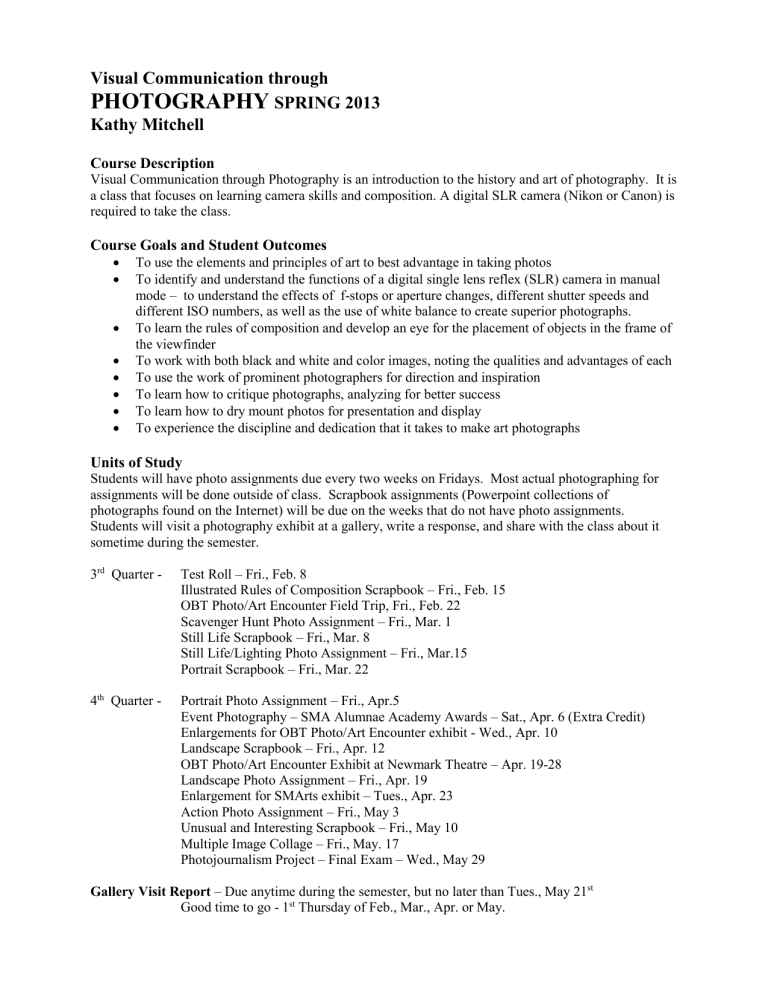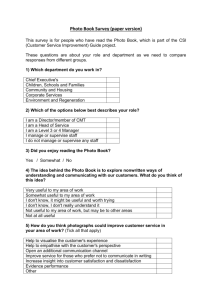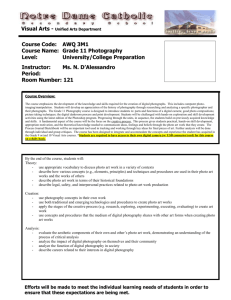Photography Syllabus - 2013

Visual Communication through
PHOTOGRAPHY
SPRING 2013
Kathy Mitchell
Course Description
Visual Communication through Photography is an introduction to the history and art of photography. It is a class that focuses on learning camera skills and composition. A digital SLR camera (Nikon or Canon) is required to take the class.
Course Goals and Student Outcomes
To use the elements and principles of art to best advantage in taking photos
To identify and understand the functions of a digital single lens reflex (SLR) camera in manual mode – to understand the effects of f-stops or aperture changes, different shutter speeds and different ISO numbers, as well as the use of white balance to create superior photographs.
To learn the rules of composition and develop an eye for the placement of objects in the frame of
the viewfinder
To work with both black and white and color images, noting the qualities and advantages of each
To use the work of prominent photographers for direction and inspiration
To learn how to critique photographs, analyzing for better success
To learn how to dry mount photos for presentation and display
To experience the discipline and dedication that it takes to make art photographs
Units of Study
Students will have photo assignments due every two weeks on Fridays. Most actual photographing for assignments will be done outside of class. Scrapbook assignments (Powerpoint collections of photographs found on the Internet) will be due on the weeks that do not have photo assignments.
Students will visit a photography exhibit at a gallery, write a response, and share with the class about it sometime during the semester.
3 rd Quarter - Test Roll – Fri., Feb. 8
Illustrated Rules of Composition Scrapbook – Fri., Feb. 15
OBT Photo/Art Encounter Field Trip, Fri., Feb. 22
Scavenger Hunt Photo Assignment – Fri., Mar. 1
Still Life Scrapbook – Fri., Mar. 8
Still Life/Lighting Photo Assignment – Fri., Mar.15
Portrait Scrapbook – Fri., Mar. 22
4 th Quarter - Portrait Photo Assignment – Fri., Apr.5
Event Photography – SMA Alumnae Academy Awards – Sat., Apr. 6 (Extra Credit)
Enlargements for OBT Photo/Art Encounter exhibit - Wed., Apr. 10
Landscape Scrapbook – Fri., Apr. 12
OBT Photo/Art Encounter Exhibit at Newmark Theatre – Apr. 19-28
Landscape Photo Assignment – Fri., Apr. 19
Enlargement for SMArts exhibit – Tues., Apr. 23
Action Photo Assignment – Fri., May 3
Unusual and Interesting Scrapbook – Fri., May 10
Multiple Image Collage – Fri., May. 17
Photojournalism Project – Final Exam – Wed., May 29
Gallery Visit Report – Due anytime during the semester, but no later than Tues., May 21 st
Good time to go - 1 st Thursday of Feb., Mar., Apr. or May.
Text and Materials
The text for the class is The Basic Photo Book by Phil Davis (Wm. C. Brown Publishers, 1992), which is provided in the classroom. Students need a digital single lens reflex camera (dSLR) with a zoom lens
(Nikon or Canon). Other equipment such as tripod, filters, shutter release cable, and close up or telephoto lenses can be useful, but are not necessary. Students are responsible for photo printing for displays and contests. Images are needed for scrapbook assignments, and mounting boards for the Landscape and
Multiple Image assignments.
Methods
Students will produce and critique photos as the main activity of the class, augmented by films, internet, speakers, and gallery visits to inspire their work.
Students will complete photo assignments and scrapbooks outside of class to make use of a wide range of subject matter and lighting conditions.
Assessment/Grading
Students must turn in paperwork along with photographs that record the f-stop and shutter speed for each photo taken as well as comments about composition, contrast, and technical issues in order to get full credit. They will write a self-evaluation of their performance. The teacher will read and confirm the evaluation. Quarter grades consist of an average of the work for the quarter. Photo assignments count double that of scrapbooks.
Grading scale: 100 or above=A+, 92-99=A, 90-91=A-, 88-89=B+, 82-87=B,80-81=B-, 78-79=C+, 72-77=C, 70-71=C-,
68-69=D+, 62-67=D, 60-61=D-, below 60=F
Semester grades will be the average of 3 rd and 4 th qtr. grades plus the Photojournalism Project.
The Photojournalism Project will act as the Final Exam grade for the semester and will count 10% of the semester grade.
There will be a summarizing activity during the Final Exam time in June.
Assignments must be handed in on the due date for full credit. Late work drops the grade one full point. If a student is absent, work must be turned in on the day she returns.
Attendance
Attendance is very important in a photography class. When a student is absent, she must arrange with the teacher to get handouts and make up the work.
Communication
Mrs. Mitchell can usually be found in the Art Room, G-2, before school, at lunch, after school, and during
Activity Block unless she has a meeting or supervision duty. A student must make an appointment to ensure that the teacher is available. Progress reports will be sent home mid-quarter if a student has a C- or below.
Classroom Expectations
Get materials and be seated when the tardy bell rings.
Store backpacks, coats, etc, under the table, not in the aisle.
Be positive in your attitude and remarks.
Respect the rights, abilities, and property of others.
Photographs follow the mission of SMA – no nudity, violence or suggestive poses.
Keep a quiet, working atmosphere.
Be responsible for the use of materials and clean up.
No food or drink in the Art Room.
Enjoy the fun of photography!




